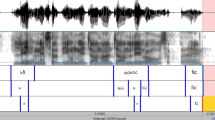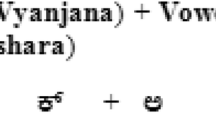Abstract
Human beings have their own speaking style which helped them in depicting their native language. The major reason behind variability in some language is due to varying dialect of the speakers. In the field of Automatic Speech Recognition (ASR), key challenge is to recognize and to generate an acoustic model which represents differences of redundant acoustic features. In this paper, an issue of dialect classification is perform on the basis of tonal aspects of laryngeal phoneme [h]. This is an empirical study of [h] sound words in four major dialects of Indian Punjabi language with two key parameters, namely F0 variation, and acoustic space, which are calculated using two formant frequencies: F1, and F2. The results are based on four different dialects which provide us some interesting hypotheses and are explored with self-created dataset. The speech analysis tool PRAAT features have been extracted and correlations are studied using Statistical Package for the Social Sciences (SPSS). Each variable has been compared with same variable of all other dialects. The results analysis showed that the fundamental frequency of these vowels are influenced distinctly in different dialectal conditions. Apart F1 and F2 have shown a significant correlation with each spoken dialect. Further work is extended through processing of acoustic information at feature level or by comparing the performance analysis using basic or hybrid Linear Predictive Cepstral Coefficients feature extraction methods. The result shows that the hybrid LPCC + F0 system achieved a Relative Improvement (R.I.) of 6.94% on Subspace Gaussian Mixture Model model in comparison to that of basic LPCC approach respectively.







Similar content being viewed by others
References
Adank P, Van Hout R, Smits R (2004) An acoustic description of the vowels of Northern and Southern Standard Dutch. J Acoust Soc Am 116(3):1729–1738. https://doi.org/10.1121/1.1779271
Adank P, Van Hout R, Velde HVD (2007) An acoustic description of the vowels of northern and southern standard Dutch II: regional varieties. J Acoust Soc Am 121(2):1130–1141
Agrawal SS, Jain A, Sinha S (2016) Analysis and modeling of acoustic information for automatic dialect classification. Int J Speech Technol 19(3):593–609. https://doi.org/10.1007/s10772-016-9351-7
Ai OC, Hariharan M, Yaacob S, Chee LS (2012) Classification of speech dysfluencies with MFCC and LPCC features. Expert Syst Appl 39(2):2157–2165. https://doi.org/10.1016/j.eswa.2011.07.065
Arora A, KadyanV, Singh A (2019) Effect of tonal features on various dialectal variations of Punjabi language. In: Advances in signal processing and communication. Springer, Singapore, pp 467–475. https://doi.org/10.1007/978-981-13-2553-3
Arora Shipra J, Rishipal S (2014) Acoustic and phonological analysis of homophones of Punjabi language. Int J Comput Sci Eng Inf Technol Res:2249–6831 [ISSN (P)]
Arslan LM, Hansen JH (1996) Language accent classification in American English. Speech Commun 18(4):353–368. https://doi.org/10.1016/0167-6393(96)00024-6
Bhardwaj V, Kukreja V (2021) Effect of pitch enhancement in Punjabi children’s speech recognition system under disparate acoustic conditions. Appl Acoust 177:107918
Boersma P, VanHeuven V (2001) Speak and unSpeak with PRAAT. Glot Int 5(9/10):341–347
Dua M, Aggarwal RK, KadyanV, Dua S (2012) Punjabi speech to text system for connected words. https://doi.org/10.1049/cp.2012.2528
Eady SJ (1982) Differences in the F0 patterns of speech: tone language versus stress language. Lang Speech 25(1):29–42. https://doi.org/10.1177/002383098202500103
Gogoi P, Dey A, Lalhminghlui W, Sarmah P, Prasanna SM (2020) Lexical tone recognition in Mizo using acoustic-prosodic features. In: Proceedings of the 12th language resources and evaluation conference, pp 6458–6461
Grzega J (2000) On the description of national varieties: examples from (German and Austrian) German and (English and American) English. Linguistik 7(3):00
GuglaniJ MAN (2018) Continuous Punjabi speech recognition model based on Kaldi ASR toolkit. Int J Speech Technol 21(2):211–216. https://doi.org/10.1007/s10772-018-9497-6
Gumperz JJ (1958) Dialect differences and social stratification in a North Indian Village 1. Am Anthropol 60(4):668–682. https://doi.org/10.1525/aa.1958.60.4.02a00050
Kadyan V, Mantri A, Aggarwal RK (2017) A heterogeneous speech feature vectors generation approach with hybrid hmm classifiers. Int J Speech Technol 20(4):761–769. https://doi.org/10.1007/s10772-017-9446-9
Kadyan V, Mantri A, Aggarwal RK (2018) Refinement of HMM model parameters for Punjabi automatic speech recognition (PASR) System. IETE J Res 64(5):673–688. https://doi.org/10.1080/03772063.2017.1369370
Kadyan V, Mantri A, Aggarwal RK, Singh A (2019) A comparative study of deep neural network based Punjabi-ASR system. Int J Speech Technol 22(1):111–119. https://doi.org/10.1007/s10772-018-09577-3
Kanwal J, Ritchart A (2015) An experimental investigation of tonogenesis in Punjabi. In: ICPhS
Kaur A, Singh A (2016a) Power-normalized Cepstral coefficients (PNCC) for Punjabi automatic speech recognition using phone based modelling in HTK. In: Proceedings of the 2nd International Conference on applied and theoretical computing and communication technology (iCATccT), Bangalore, India, pp 372–375. https://doi.org/10.1109/ICATCCT.2016.7912026
Kaur A, Singh A (2016b) Optimizing Feature Extraction Techniques Constituting Phone Based Modelling on Connected Words for Punjabi Automatic Speech Recognition. In: Proceedings of the 2nd International Conference on Advances in Computing, Communications and Informatics (ICACCI), Jaipur, India, pp 2104–2108. https://doi.org/10.1109/ICACCI.2016.7732362
Kaur J, Singh A, Kadyan V (2020) Automatic speech recognition system for tonal languages: state-of-the-art survey. Arch Comput Methods Eng. https://doi.org/10.1007/s11831-020-09414-4
Kumar Y, Singh N, Kumar M, Singh A, AutoSSR (2020) An efficient approach for automatic spontaneous speech recognition model for the Punjabi Language. Soft Comput. https://doi.org/10.1007/s00500-020-05248-1
Lata S, Arora S (2013) Laryngeal tonal characteristics of Punjabi—an experimental study. In: 2013 International Conference on Human Computer Interactions (ICHCI). IEEE, pp 1–6. https://doi.org/10.1109/ICHCI-IEEE.2013.6887793
Lau LSP, James CJ (2004) A tonal language test of speech perception: Cantonese spondee lists. Asia Pac J Speech Lang Hearing 9(3):200–219. https://doi.org/10.1179/136132804805575877
Ludwig J (1982) Native-speaker judgments of second-language learners’ efforts at communication: a review. Mod Lang J 66(3):274–283. https://doi.org/10.2307/326629
Mishra D, Bali K (2011) A comparative phonological study of the dialects of Hindi. ICPhS
Packard JL (1986) Tone production deficits in nonfluent aphasic Chinese speech. Brain Lang 29(2):212–223. https://doi.org/10.1016/0093-934x(86)90045-3
Peng G, Wang WSY (2005) Tone recognition of continuous Cantonese speech based on support vector machines. Speech Commun 45(1):49–62. https://doi.org/10.1016/j.specom.2004.09.004
Ping TANG, Ivan YUEN, Rattanasone NX, LiqunGAO DK (2019) Acquisition of weak syllables in tonal languages: acoustic evidence from neutral tone in Mandarin Chinese. J Child Lang 46(1):24–50. https://doi.org/10.1017/S0305000918000296
Povey D, Zweig G, Acero A (2011) The exponential transform as a generic substitute for VTLN. In: IEEE ASRU
Rao R, Aishwarya A (2019) Acoustic correlates of stress in tone language: a comparison between Indian and Chinese Languages. Lang India 19:32
Ravinder K (2010) Comparison of hmm and dtw for isolated word recognition system of punjabi language. In: Iberoamerican congress on pattern recognition. Springer, Berlin, Heidelberg, pp 244–252. https://doi.org/10.1007/978-3-642-16687-7_35
Shannon BJ, Paliwal KK (2005) Influence of autocorrelation lag ranges on robust speech recognition. In: Proceedings (ICASSP'05) IEEE International Conference on Acoustics, Speech, and Signal Processing, vol 1. IEEE, pp I–545. https://doi.org/10.1109/ICASSP.2005.1415171
Singh P, Dutta K (2011) Formant analysis of Punjabi non-nasalized vowel phonemes. In: 2011 International Conference on Computational Intelligence and Communication Networks. IEEE, pp 375–380. https://doi.org/10.1109/CICN.2011.79
Singh P, Lehal GS (2010) Corpus based statistical analysis of Punjabi syllables for preparation of Punjabi speech database. Int J Intell Comput Res 1(3)
Singh A, Pandey D, Agrawal SS (2015) Analysis of Punjabi tonemes. In: 2015 2nd International Conference on Computing for Sustainable Global Development (INDIACom), IEEE, pp 1694–1697
Singh A, Kadyan V, Kumar M, Bassan N (2019) ASRoIL: a comprehensive survey for automatic speech recognition of Indian languages. Artif Intell Rev. https://doi.org/10.1007/s10462-019-09775-8
Sinha S (2015) Analysis and recognition of dialects of Hindi speech. Int J Sci Res Multidiscip Stud 1:26–33
Tian Y, Zhou JL, Chu M, Chang E (2004) Tone recognition with fractionized models and outlined features. In: 2004 IEEE International Conference on Acoustics, Speech, and Signal Processing, vol 1 IEEE, pp I–105. https://doi.org/10.1109/ICASSP.2004.1325933
Tsunoda T (1971) The difference of the cerebral dominance of vowel sounds among different languages. J Audit Res 11(4):305–314
Wang L, AmbikairajahE, Choi EH (2007) A novel method for automatic tonal and non-tonal language classification. In: 2007 IEEE International Conference on Multimedia and Expo. IEEE, pp 352–355. https://doi.org/10.1109/10.1109/ICME.2007.4284659
Yan Q, Vaseghi S, Rentzos D, Ho CH, Turajlic E (2003) Analysis of acoustic correlates of British, Australian and American accents. In: 2003 IEEE workshop on automatic speech recognition and understanding (IEEE Cat. No. 03EX721) IEEE, pp 345–350. https://doi.org/10.1109/ASRU.2003.1318465
Zhang YS, Takahashi DY, Liao DA, Ghazanfar AA, Elemans CP (2019) Vocal state change through laryngeal development. Nat Commun 10(1):1–12. https://doi.org/10.1038/s41467-019-12588-6
Author information
Authors and Affiliations
Corresponding author
Additional information
Publisher's Note
Springer Nature remains neutral with regard to jurisdictional claims in published maps and institutional affiliations.
Rights and permissions
About this article
Cite this article
Goyal, K., Singh, A. & Kadyan, V. A comparison of Laryngeal effect in the dialects of Punjabi language. J Ambient Intell Human Comput 13, 2415–2428 (2022). https://doi.org/10.1007/s12652-021-03235-4
Received:
Accepted:
Published:
Issue Date:
DOI: https://doi.org/10.1007/s12652-021-03235-4




